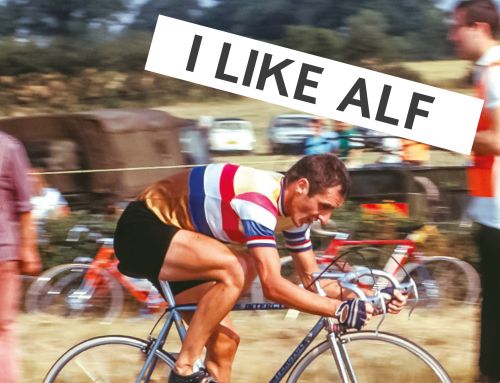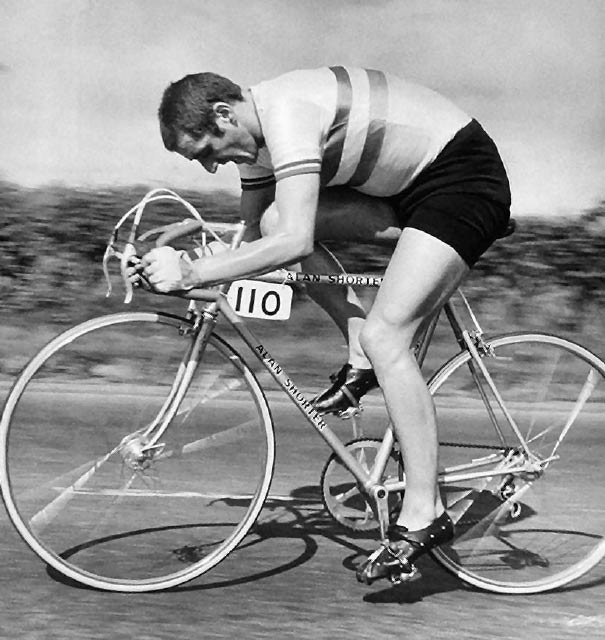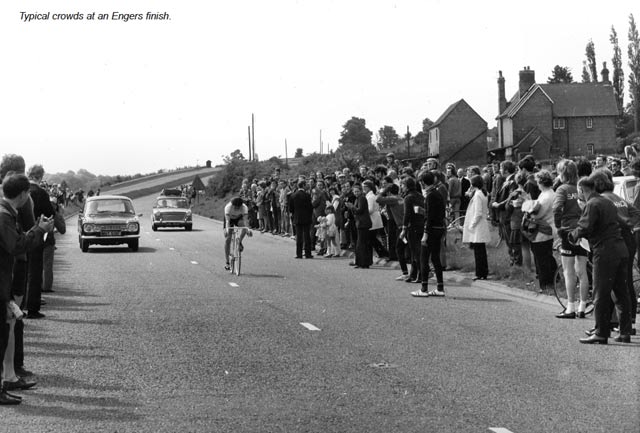 You can’t do time trialling in the UK without becoming dimly aware of a mythical figure called Alf Engers. Emerging out of that ‘golden age’ of the 60s and 70s when timetrials ruled the road, you pick up the odd snatched comments about the first sub-50 minute 25 mile TT on a road bike (no TT bars). Riding in the middle of the road. Brushes with authority. The London baker doing a night-shift to 3 am and then breaking records at 6 am. Even now, as the author mentions, you can still hear the phrase “But, what would Alf Engers have done?”
You can’t do time trialling in the UK without becoming dimly aware of a mythical figure called Alf Engers. Emerging out of that ‘golden age’ of the 60s and 70s when timetrials ruled the road, you pick up the odd snatched comments about the first sub-50 minute 25 mile TT on a road bike (no TT bars). Riding in the middle of the road. Brushes with authority. The London baker doing a night-shift to 3 am and then breaking records at 6 am. Even now, as the author mentions, you can still hear the phrase “But, what would Alf Engers have done?”
It all amounts to whispers from the past and, in the absence of direct testimony, you place your subjective impressions above any reality. Muffled opinions in between the course codes and obscure regulations. The funny thing is whenever I met the late John Woodburn, he would always tell me how he had to start a time trial with a working bell, and when he got around the corner from the start-keeper, he would throw it off in disgust. It’s a shame I never asked about his times racing with Alf Engers. It never occurred to me, but that’s one of the many things I learnt from the book.
The thing about legends of the past is that you never quite know fact from fiction, exaggeration from reality. Timetrialling doesn’t tend to throw up too many characters; it’s a sport for the nerds and obsessive attention to detail. A rock star in a sheepskin coat who snubbed his nose up at the stuffy RTTC by riding too fast has all the makings of a great story.

When I heard Paul Jones would be writing a book on Alf Engers, I thought somehow that this was a match made in Heaven. If ever a writer could do justice to a biopic of ‘The King’, it was P. Jones – who can make even sparsely populated hill climbs sound exotic and exciting. Except with Alf – ‘Heaven‘ is perhaps not quite the right epitaph; more like a “match made in Heaven – with a touch of the devil’s mischief thrown in for good measure.”
If there is a drawback to the book, it is short. I read in two days. But, it reminds me of the pastor who gave an interminably long sermon of two hours – and when asked why his sermon was so long, he responded that he didn’t have time to make it short. Brevity is the soul of wit and all that. The benefit is that the book moves along at a great pace, evoking the spirit of the times from post-war Britain to the slow evolution of parochial time-trialling. At last, I have a direct understanding of Engers. – What made him tick, what he did for the sport, the great battles of the past – all within the context of today. It was like finding out that Robin Hood is a real historical figure, and he was a pretty decent bloke to boot.

As a story, you couldn’t make it up. It is hard to understand why a full-time baker could be banned from the sport for five years (age 22-27), because he had one failed season as an independent. It seems the spirit of amateur endeavour were lost in the rules, regulations and prejudices of the time. It is Alf’s comeback which is really the riveting part of the book. National records, complaints, counter-complaints, detractors and supporters in equal measure – it is all told with great pace, humour and sympathy to the rider who was breaking both records and pulling the RTTC out of its carefully controlled past.

Overall it is a great read. It evokes the spirit of Alf Engers and the interesting times which he lived through. The book is unashamedly told with sympathy to Alf’s perspective, but this is not to detract, it is about time Alf gets to tell his story in a suitably appealing way. The book successfully weaves anecdotes, stories and quotes from Alf within the context of the time. It is more than just about Alf Engers. To really understand the Engers story, we have to appreciate the atmosphere of the period. It is a book which leaves you hungry for more and is an essential read for anyone who considers themselves part of the time trialling community, but will appeal to a much broader audience. It is a human drama, which happens to occur within a world of drilled handlebars and self-transcendence in athletic endeavour.
There is probably another point of view. The ‘North London Mafia’ and suits of the RTTC would undoubtedly tell a different version of history, but I cannot imagine it would make much of an interesting read. Nobody can deny ‘Life lessons from Alf Engers’ is at the very least a lively and thought-provoking story.
Alf Engers – how to buy at Traumfahrad
***
If I can post one self-indulgent remark. There is one error in the book on p.111 the author writes about the Bristol South super-hilly 28 mile time trial, which ‘no-one thanked us for’ I beg to differ. It was the best and most memorable time-trial of my career.

I am glad I rescued this post from spam folder.
Welcome back to cycling uphill even if it gives you pain at least you know it is worthwhile when you get to the top.
I’ll have to get hold of a copy, as a schoolboy I entered the time trial world in 1966, when 10 mile TT’s were evening only events and the courses were out and back and the half way point was a turn in the road. I joined the Barnet then when Engers was in his comeback glory years. From memory, along with Alf ‘The King’ Engers there was Paul ‘Porky’ Bennet, Alan ‘The Bone’ Rochford and his brother John, Joe Mummery, Trevor Morgan, Barry Chick who went on to built Alfs’ frames and Alan Shorter whose North Finchley shop was synonymous with Barnet CC.
I raced time trials, road races, grass tracks, hard tracks and cyclocross, never winning just one of those who made up the field of riders. I remember Beryl Burton coming past me on the F4 25 (South Mimms to Hatield course) like an express train,and in those days women started behind the men. Fond memories, great times, still have my Alan Shorter TT bike and Dave Davey track bike. Alf lives a few miles from where I am and I’ve had the privilege to meet him when he honoured us by attending to a showing of the film about him at ‘The Woodman’ in Nuthampstead.
Rod – can you share the route of the F4 25? I can’t find in via Google.
It has been destroyed by the M25 and associated road builds. From memory and using google maps:
It started on the B556 near the junction of the road from Shenley. Proceed East then turn left up hill on A1081 then turn right at the roundabout, east on the A414 towards Hatfield. Near Hatfield bear left onto what is now the A1 .
Through a couple of roundabouts, turn right towards Hertford on the A414. Probably the longest uninterupted stretch of road once you pass the small roundabouts to turn at the A414 and B1455 which I think was called Hertingfordbury. The turn was that roundabout. Retrace along A414 and A1 past the point where the bear left and head towards Welham Green. The problem here for course designer was to get back on the A414 towards the start, as there was no convenient roundabout and avoiding a right turn. Turn left on what is now called south way to the roundabout and retrace from there, crossing and rejoining the A1 then turn left on the A414 heading west. retrace to start via A414,
I hope that makes sense, it was my local course and has over 20 roundabouts or turns involving a change in direction, more like interval training than a TT.